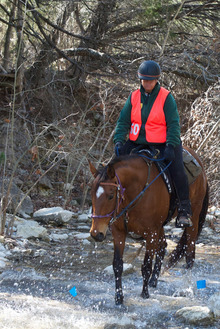With the holiday season around the corner, many of us hang up the bridle and give our stalwart pony a couple of months off with the chill of the season. Just because the snow begins to fly over much of Canada and the northern United States doesnât mean we canât train for and hit a distance ride or two in the warmer parts of the nation.

Riding your horse during winter weather!
Winter horseback riding can be fun for riders of all ages - think hot chocolate and helmet covers - so donât cross cold-weather rides off your list.
© 2015 by Jim Edmondson
In fact, one of the highlights of our childrenâs endurance riding careers included traveling to Southern Californiaâs desert region and doing a one-day 100 mile ride at the Twenty Mule Team endurance ride one February. (Our family of five has completed more than 15,000 miles of endurance ride competitions as members of the American Endurance Ride Conference.)
Being from central Utah, winter temperatures on some days never get above freezing, so how do you prepare kids and their trusty steeds to participate in winter rides? Hopefully we can give a few helpful tips that can help families be successful with winter training.
When asked about her experience with training in the cold as a junior, endurance rider Heather Herman had some great advice. Being from Montana, Heather has plenty of experience with riding in the cold and addressed one of the most important issues to successful winter training: riding apparel to suit the season.
She stressed the importance of having a good pair of waterproof boots as well as a rainproof coat.
âBeing cold is one thing, but being wet and cold is an entirely different ball game,â said Heather. âIt is important to start with more layers than one needs. As you warm up, you can always shed layers and tie them to your saddle.â
Choose to wear moisture-wicking fabrics next to your skin so perspiration wonât leave you feeling damp. Fleece is an exceptional choice, and fleece-lined riding breeches are golden for cold weather comfort.
Another nifty trick is to cover your helmet with a fleece helmet cover. A lot of heat is lost from your head, whether youâre a kid or a grown-up.
Helmets alone offer some protection from the cold, but a fleece helmet cover can make the difference between an agonizing freezing experience and a glorious winter ride.
Gloves are also a necessity. We as parents knew that if the kids got cold hands or cold feet we were pretty much done with that dayâs training.
Silk glove liners usually complement any riding glove well. Silk is a natural fiber that is very effective in wicking moisture from the skin and adding warmth.
Now letâs move on to the fun stuff. There is nothing better when you are chilled to the bone than a mug of hot chocolate. Hot chocolate can be helpful in more than one way. It can warm you from the inside out, and it can add some extra needed calories to your training ride.
When riding in the cold, not only does your horse need extra calories to keep warm, but so do you. Make sure you take some healthy, fun snacks along.
Training your horse in the ice and snow is completely different than training throughout the sunny days. It is important to schedule your rides during the warmest part of the day, finishing the ride with enough daylight to get your horseâs woolly winter coat dried out before the frigid night temperatures.
Most of the time we start our winter rides in the late morning, and try to be home by early afternoon, allowing enough time for our horses to cool off and dry off.
Winter training in the snowy regions usually poses the obstacle of challenging footing, and you may decide that your horse is trying the art of ice-skating. It is essential that you slow your horse down with snow and icy conditions.
It is amazing how your horse can shed the winter pounds and get into condition just by walking through snow. Have you ever tried walking any distance in knee-deep snow -- it is a workout! Try it sometime and you will better understand what you are asking your horse to do.
When it comes to winter riding you donât have to do a whole slew of miles to get your horse in shape. It is more important to gauge your conditioning by the hours your horse is on the trail, rather than the miles covered. Remember to slow down and keep you and your mount safe.
I would like to challenge equestrians to experience the exhilaration and great accomplishments of winter trail riding. With a few adjustments you and your horse may discover a great adventure, and I would bet that your horse will thank you, too.
More information on endurance riding is available by visiting www.aerc.org or by calling the AERC office at 823-2260. By request, the office will send out a free information packet to prospective members.
By Terry and Nalisa Bradley
